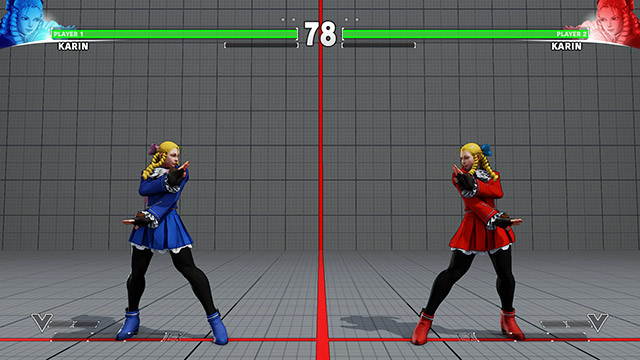I’ve gone over and over in my head how to start my review of Street Fighter V, and every time I think I’ve figured out the way I want to kick it off, I’ve ended up scrapping that decision. So, instead, I’m going to start with a story.
I’ve been playing Capcom’s now-legendary fighting game series since its original release hit arcades with what, at the time, seemed like all of the impact of a dull thud. (Heck, I even had the game in its Fighting Streetform on the Turbografx-16.) When the Street Fighter II craze took the world by storm, I was there from the beginning, racking up win streaks with Chun-Li until the skill level of other arcade goers started rocketing past my own (which, admittedly, didn’t take long). The long-awaited home release of Street Fighter II was the reason I finally broke down and got an SNES—only to then wait and pick up Championship Edition on the Genesis instead. I truly fell in love with the series through Street Fighter Alpha, with its cast of characters that appealed to me far more than most of the original world warriors. And though I could never hope to compete with the fighting game community back in my hometown in Street Fighter III, I still had a deep appreciation for everything it did (or tried to do) in pushing the franchise forward.
It was Street Fighter IV, however, where I decided that I finally wanted to do the one thing I’d avoided for so long: truly try to understand the game better, and improve my ability based on that knowledge. Fighting games are a fascinating genre, one where you can have tons of fun at any skill level, but one where your appreciation increases exponentially with every step of progression that you take. So, for me, Street Fighter IV was probably the most important release in the series. Even if I’m nowhere near ready to make an EVO run—and, honestly, probably never will be—it was the moment where my love for the game became deeper, richer, and centered more on what I could actually do once a round began, not what I wished I could do on some far-off future day.
And yet, I’m now not certain I can play Street Fighter IV anymore. After the fourteen months of time I’ve spent covering its successor, Street Fighter V, after numerous hands-on events, after participating in every beta that Capcom has run, after having tried my best in two different small-scale tournaments with my compatriots in gaming media, and now after spending time with the final retail release, going back to SFIV is like going on a date with an ex.
At first, it seems like a fun idea, and there’s an excitement when you sit across the table from one another at the fancy restaurant you picked out. Pretty quickly, however, the understanding truly sinks in: you’ve moved on. You can remember why you loved them when you did, you can reminisce about the good times you had together, but your life is now in a different place from where it was when the two of you were together. What you want now is to spend time with the new flame you’ve found, the one who can spark your interest in those ways your ex never could.
Street Fighter V is that hot, exciting new flame. Even in the relatively short time I’ve had to play this next chapter across those months, it’s already spoiled for me that previous entry that stood tall and proud for the eight years it ruled the fighting game world.
Part of the reason is that, in Street Fighter V, Capcom got to give Street Fighter a spring cleaning of sorts. In the span of its life, Street Fighter IV grew and evolved in ways that, for the most part, made the game a better experience. And yet, while it’d be unfair to knock SFIV for doing what any fighting game needs to do if it has a long enough life, there’s something to be said for getting that chance to get a fresh start. The team has cleared out a lot of the baggage that came to clutter Street Fighter, and what’s left is a home that doesn’t have as much stuff tucked away in its drawers and closets as it used to, but one which now feels new again.
There’s some potential justification for anyone who will say that Street Fighter V is now “too simple” of a game, and the decisions that have been made in doing so will be proven right—or wrong—in the years to come. I can’t help but love what’s been done here, however. I’ve long thought that fighting games should be about how you play and what you do with your skills, not the ability or inability to perform complex joystick movements or fully grasp an over-abundance of additional combat techniques. This is a perfect example of “less is more” to me, and while SFV will certainly be a better point of entry for newer or more casual players, I really do feel like there will also be the depth that’s desired by the higher-level members of the community. I certainly hope that’s the case, because I’d hate to see what’s been crafted here get bogged down later by additional bloat in a desperate attempt to turn around a game that failed to find its footing in the market.
A big element that strengthens my hope in Street Fighter V’s potential longevity is its V-Gauge options. While it isn’t a new idea to the genre—BlazBlue, for example, showed fantastically what you can do with similar ideas—giving each character in the game their own personalized gameplay elements is something I never knew Street Fighter needed until I got it. Through the use-them-whenever-you-want V-Skills and the gauge-needing V-Triggers, even ancient characters like Ryu and Ken have some of that new character smell to them—which, let’s be fair, they really needed at this point. Though this extra layer of personally really does add a lot to the game, there’s a potential point of failure: some of the characters definitely feel like they’ve had less thought put into them than others. While he’s stolen it from Street Fighter III, Ryu’s V-Skill parry really sets him apart from everyone else, as does Karin’s V-Trigger that returns (and remixes) her rekka-style attacks from Alpha 3. Meanwhile, far too many characters for my liking have V-Triggers that just buff attack strength or distance, and some V-Skills come off as moves that could easily have been standard specials instead. The problem with trying to make every roster choice unique is that’s actually a daunting task, and while Capcom has gotten it right more than they’ve gotten it wrong here, the low points show the cracks that exist in the entire concept.
Of course, the bigger factor to having a roster that offers a variety of distinct characters is the characters themselves. Whenever you have a series that has a sizable roster of fighters, it’s got to be a stressful job to figure out who will and won’t make the cut when you need to push the reset button. (Go ask SNK how things went with The King of Fighters XII if you need proof.) Coming off of Ultra Street Fighter IV’s 44 character choices, Street Fighter V’s 16 roster slots meant a whole lot of cutting had to be done. The thing is, some of my favorite moments in fighting games have been their first releases, when rosters were at their leanest, and every inclusion felt special—and that’s the case here as well. Capcom’s goal was to include characters that could justify their inclusion in terms of what they could offer both the game and players. I think it’s an incredibly strong lineup of characters—probably my favorite initial roster since Street Fighter Alpha—and I’m especially happy to say that all four of the new characters introduced here are great additions to both the roster and the Street Fighter mythos. Some fans are furious that their old standbys are nowhere to be found, but guess what? None of my mains from SFIV are present here either. So, I’m now learning someone new—Karin, who is thankfully sans-school uniform—and that’s something I’m finding to be hugely exciting. Seriously, if you’ve never tried breaking out of your comfort zone and giving someone new a go, do it—especially you damned Ken players.
If you really can’t live without certain characters, more are coming. If you’ve not heard already, there will only be one version of Street Fighter V—this one—and it’ll be continually updated with free patches, purchasable characters and content, and more in the weeks and months to come. While not having to worry about buying additional discs or lagging behind with an older version of the game than your friends own anymore, one of the most interesting twists on this plan is that most DLC content will be earnable through the game. Players can, of course, spend real money to unlock their favorite fighter or alternate costume as soon as they’re released, or you can earn in-game “Fight Money” to gain access to them for free. It’s hard for me to give you precise figures on how fast you’ll earn Fight Money, because the servers were reset on a regular basis pre-launch, so I’d often find my bank account zeroed when I returned the next day. I can tell you, however, that playing through all of the launch-day story content, and an afternoon or so of online matches, easily netted me around 120,000-plus Fight Money. Of course, how much we’ll be earning for player matches could certainly be tweaked by release. No matter what, it’s a brave choice by Capcom, and I’m eager to see how the idea plays out as the game grows in both scope and player base.
Beyond the gameplay itself and the characters you’ll be using, fighting games often excel or suffer depending on the other elements the developer has built into them. There’s a lot I could list out and get into that would bloat my already long review, so instead, I wanted to focus on two specific ones. The first is Capcom Fighters Network, the new “community” aspect of Street Fighter V. There’s a lot of interesting stat-tracking going on now in the game, and you can keep up with friends or rivals, save and watch replays, see who’s doing the best around the world (or where you rank), and more. All that stuff is great, but the interface and integration in SFV is surprisingly low-key. I can’t tell if the dev team purposely wanted to keep things simple, if there’s still a lot in store for that segment of the game, or if I expected more than I should have. I think there’s a lot that could be done with all of the community stuff, and I hope they indeed do more with it in the future.
The other is something I know some of you will be especially interested in: the ability to use PlayStation 3 joysticks and/or wired controllers. Yes, the option is there, and I’m glad that Capcom was able to integrate it for everyone who wasn’t in a place to upgrade their controllers or joysticks to fully make the console generation jump. It does come with caveats, however. In order to use a PS3 device, you’ll need to have a DualShock 4 up and running, and then tell the game to recognize the legacy controller. Unless you’ve set it not to, it’s likely your PS4 controller will go to sleep as you’re using the older stick, and once it does, the connection is broken. If you keep the DualShock 4 from auto-napping, there’s another problem: the system will think nothing is going on, because it’s not getting any information from the controller(s) it recognizes, so it too has the chance of shutting down. Then, I had another concern. While it’s completely unscientific and based on nothing more than my gut feeling, I swear that controls didn’t feel as precise or responsive when I tried my older stick. This is definitely a case of “your mileage may vary”—so be aware that you might end up wanting to purchase a PS4-supporting device anyhow.
There’s then a few smaller nitpicks that I simply have to mention. As part of the CFN integration, players can now pick a unique Fighter ID that’s different from their PSN or Steam handle. As someone who’s stuck with a PlayStation ID that I’ve long outgrown, I’m hugely thankful to Capcom for that. However, implementing that means that it takes more work to figure out what someone’s proper name is if you want to message them post-fight. Street Fighter V has a built-in Messages system, so I’d really love to see that also used for in-game communication between players. Saving replays, too, is still more cumbersome than it should be—just give us an option post-match to save the replay to our profile, and problem solved.
Finally, there’s this:

In the early days of Street Fighter V, the character portraits next to the lifebars were full color. At some point this changed, and I’m sure it had to do with the old artwork being distracting during fights (or something along similar lines). However, Capcom has now set it to always default to Player 1 being blue, and Player 2 being red. Unfortunately, this can cause legitimate misunderstanding when playing, in those times when you quickly look up and the color mismatch suddenly has you questioning which side you were on again. The screenshot above shows what is by far the worst case of this currently in the game, as red Karin is actually the blue Karin lifebar, and vice-versa—but as more color choices and alternate outfits come along, it could easily not be the last.
And now, let’s address the elephant in the room. While a handful of suggestions have gone around as to why they’ve done what they’ve done, Capcom has—in Street Fighter V—effectively released an unfinished game.
If you’re like me, and your interests in a new fighting game center almost wholly around online competition or local Versus mode battles, you’ve little reason not to jump in right off the bat. Battle Lounges—Street Fighter V’s take on lobbies—are currently limited to only two players, without any options for just watching the matches unfold if you’re not a participant. (An update next month will bump the member limit to eight, and allow those not playing to watch the current match.) Beyond that, most of what you’ll probably want will be there on day one. Two players can hop in locally, pick a stage and their characters, and go head-to-head; you can search for either Ranked or Casual matches; or, you can let them come to you. For that last option, Capcom has really beefed up the work they put into Ultra Street Fighter IV’s background matchmaking tech. Not only can you suddenly be tossed into a bout while in training or arcade modes, you can even find a match when in the main menu or browsing other sections. Once you are matched up, I can’t say enough good things about Capcom’s new “Kagemusha” netcode. I know some out there have had issues with lag or fight rollback, but across both the betas and the final build of the game, I’ve been surprised how smooth most of my fights have been.
It’s those single-player-mode fans out there, the ones that prefer to fight battles solo rather than square off against others online, that’ll feel like something’s lacking here. Street Fighter V’s much-touted dramatic story mode missed the party, and is set to arrive fashionably late in June. Character-specific stories are present, but they’re woefully short, with most being clearable in 10 minutes or less (even when paying attention to the cutscenes). Daily Challenges will give players a constantly-refreshed roster of tasks to complete for Fight Money, but they won’t be here until March. Versus mode offers no way to play against the computer, with that option left to a kinda-sorta solution of turning on CPU AI in Training. And, with nothing akin to the standard Arcade mode, the only real option you’ll have when you’re not interested in narrative is playing through Survival again.
The disparity between what single-player fans will get out of Street Fighter V at launch, and what multiplayer-focused fans will get, has been a real point of struggle for me in writing this review. On one hand, Capcom has given us a clear roadmap for when the missing content and features are coming, and in four months’ time, many of the complaints of the moment will be answered. On the other, we here at EGM tend to follow the belief that if a company is ready to ask you to pay full price for a game at launch, then that game is ready to be criticized on the same level that any other full-priced released would be. I can’t help but think back to Splatoon last year, where I found myself in almost the exact same situation: reviewing a game that felt unfinished, but where the content was already scheduled and announced for release in the months after launch. (And when the content did come, the game grew to be as good as I was sure it would end up being.)
I wish this situation hadn’t have happened, because it’s caused a grey cloud to hang over what is, in so many ways, a fantastic game. From its gorgeous visuals, to its solid 60fps framerate, to its stylish new UI, to its superb soundtrack, to its familiar-yet-fresh gameplay, to its rich character roster, to its robust netcode, to so many other things, Street Fighter V feels like the evolution that the series needed—and that the fans deserved. As it stands, at this moment, we’re getting a game that unquestionably feels incomplete. It also, however, feels like just the first step in what’s going to be a long and exciting adventure of world-spanning street fighting.
If you just can’t convince yourself that the package would be worth your hard-earned cash at this point, that’s okay—wait until June, and see if you change your mind. For the rest of you, I have no hesitation in saying that Street Fighter V is already worth both your time and your money. Plus, you have to remember: the longer you wait before jumping in, the more unstoppable my Karin will be when we meet on the internet battlefield.
|
★★★★☆
Street Fighter V paves the way for the future of Capcom’s legendary fighting game series—but it’s also a release that’s relying on near-future updates in order to feel like a finished product. Once they come, however, this should really be something special. |
Developer Capcom, Dimps Publisher Capcom ESRB T - Teen Release Date 02.16.2016 |
| Street Fighter V is available on PlayStation 4, PC. Primary version played was for PlayStation 4. Product was provided by Capcom for the benefit of this coverage. EGM reviews on a scale of one to five stars. | |

Mollie got her start in games media via the crazy world of gaming fanzines, and now works at EGM with the goal of covering all of the weird Japanese and niche releases that nobody else on staff cares about. She’s active in the gaming community on a personal level, and an outspoken voice on topics such as equality in gaming, consumer rights, and good UI. Check her out on Twitter and Mastodon.





